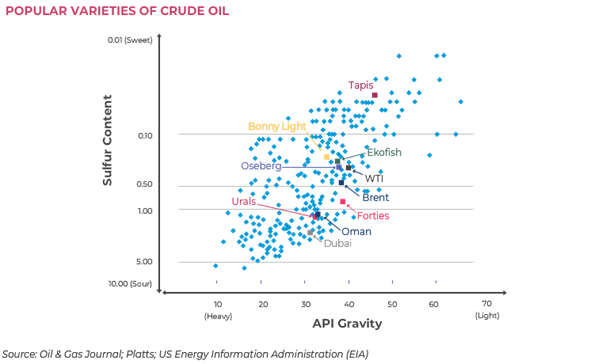Crude oil explained: What it is and its characteristics
Despite the growth in sustainability concerns and the emergence of renewable energy and other green initiatives, crude oil remains central to the functioning of modern economies. It continues to hold the largest share of the world’s energy mix and powers most forms of transport through its refined products. It is also the principal input for many chemical processes and is used in the manufacture of numerous everyday products.

What is crude oil?
Crude oil is a black, brown, or amber liquid whose chemical composition includes a complex mix of hydrocarbons, heteroatom compounds, and metals.
It is found in liquid or gaseous form in underground pools or reservoirs, in tiny spaces within sedimentary rock, and near the earth’s surface in oil sands.
Crude oil in its simple form has very limited use as a furnace fuel, but by breaking the long complex molecules into smaller molecules through the oil refining process, high value products such as gasoline, diesel, and jet fuel can be obtained.
Crude oil, and petroleum products that are made from it, are referred to as fossil fuels because they are formed from the remains of animals and plants that lived millions of years ago in a marine environment.
Over time, the remains of these animals and plants were covered by layers of sand, silt, and rock.
Heat and pressure from these layers turned the remains into what is now called crude oil.
Globally, crude oil remains one of the most important fuel sources, despite green or renewable initiatives.
However, discovering, extracting, shipping, and refining crude is a long process, and the infrastructure needed to support this process must be in place.
This involves thousands of miles of oil pipelines across countries, storage facilities in major oil trading hubs, and multiple refineries.
As a result, in aggregate the global oil industry is a multi-trillion dollar business today.

Characteristics of crude oil
Although it is common to talk of crude oil as a homogenous substance, it actually comes in almost 200 different varieties or “grades.” Each grade has differing specifications, which affect its value compared to others. It is important to note that buyers and sellers of a particular grade of crude oil value its characteristics differently depending on their needs or capabilities.
The chemical nature of a crude oil is assessed from an assay. As crude oil has become more openly marketed and traded, many companies publish assay details publicly. Of the many specifications that can be obtained from an assay, those listed below are perhaps the most important in terms of understanding a crude oil’s value.
[Gold: Demand, supply, and price explored]
API gravity
Crude oil is categorized as light or heavy according to its API gravity, which is a measure of its density against the density of water (API = American Petroleum Institute, a trade association that represents all aspects of the US oil and natural gas industry). Water has an API of 10, and any oil with an API above 10 will float on water. Crude oils measure between 10 and 60 – the higher the number, the lighter (less dense) the crude oil.
In general terms, the lighter a crude oil, the higher the price it should attract in the market. Lighter crude oils are normally deemed more valuable as they contain greater quantities of hydrocarbons that can be converted into gasoline.
Sulfur content
Sulfur is a contaminant that is present to a greater or lesser extent in all crude oils. Those with less than 0.5% sulfur by weight are typically referred to as low sulfur or “sweet.” High-sulfur crude oils have a sulfur content greater than 2% and are referred to as “sour.” Crude oils with sulfur content between these two values are referred to as medium-sulfur.
Environmental legislation to burn cleaner fuels means that the sulfur has to be removed in the refining process, which incurs a cost that depends on the refinery and the fuel specification being produced. It used to be generally true that low-sulfur crude oils traded at a premium to high sulfur crude oils, but with advances in sulfur removal techniques and crude oil blending requirements, this is not always the case.
Total acid number (tan)
The TAN is a measure of the acidity of a crude oil. It is based on the number of milligrams (mg) of potassium hydroxide (KOH) required to neutralize one gram of crude. Acid crude oil means that the acid number is greater than 0.5mg KOH/g, and high TAN crude typically refers to an acid number higher than 1.0mg KOH/g. Highly-acidic crudes can cause handling difficulties and corrosion issues for refiners, which can alter their value in a negative sense.
[What are ferrous metals? Supply and demand, trading, and hedging explained]
Paraffinic & naphthenic crudes
All crude oils contain a percentage of paraffins and naphthenes in their chemical makeup. Depending on the intended use of the products, these characteristics can alter a crude oil’s value.
Paraffins (alkanes) are good for making ethylene and propylene, which are the building blocks of petrochemical and plastics manufacturing. Naphthenes (cycloalkanes), along with a crude oil’s aromatic compound components, are good for gasoline production.
The chart below maps crude oils by density and sulfur content, with some well-known grades highlighted.

This content is taken directly from the Intuition Know-How course on commodities.
What is Intuition Know-How?
Intuition equips over 2 million financial services professionals annually with the knowledge to deliver in the rapidly moving global marketplace. Our extensive Know-How content library is trusted by the world’s largest investment and commercial banks, leading asset managers, insurance firms, regulatory bodies, and professional services firms.
Click the image below to learn more about Know-How.


